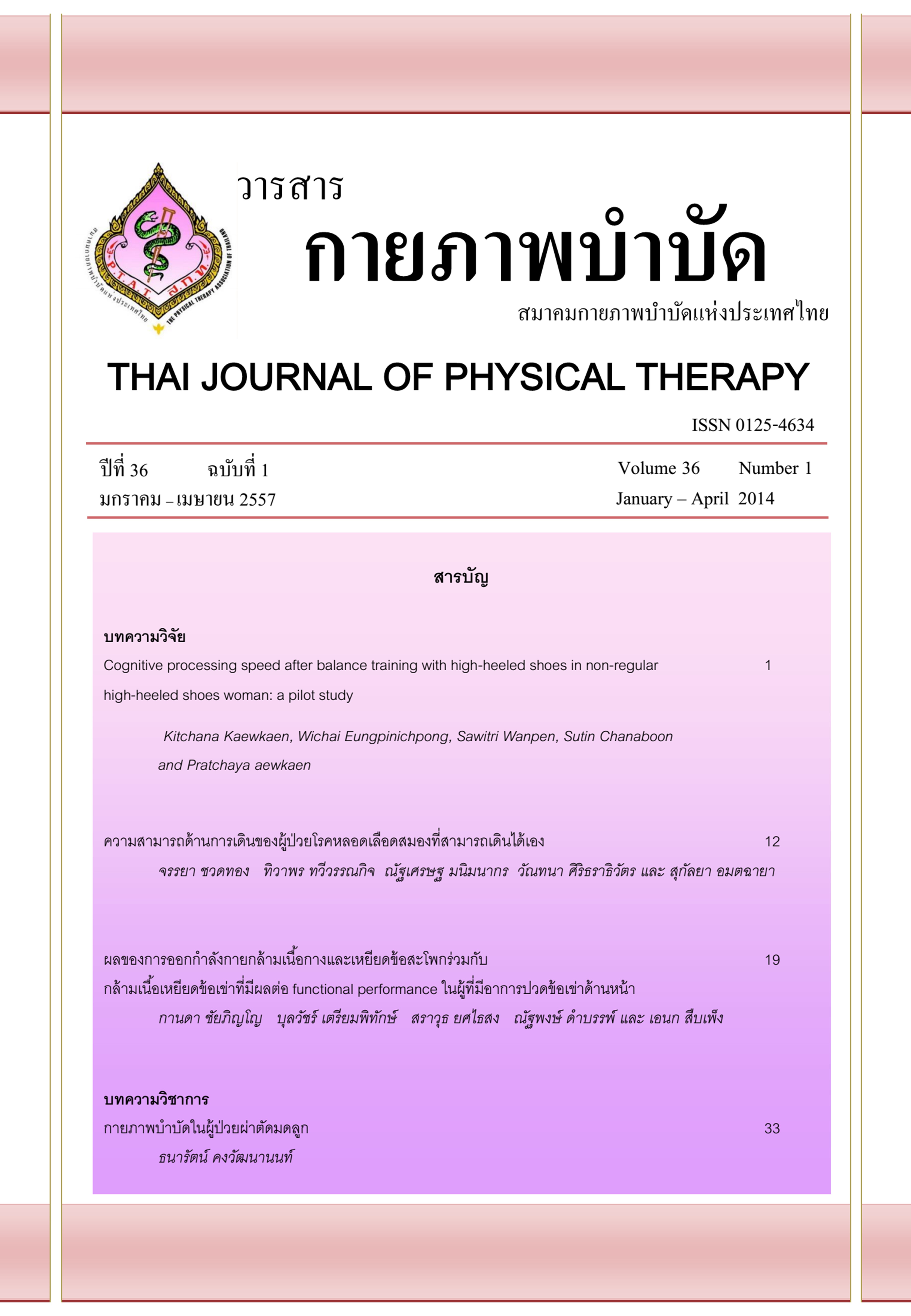ความสามารถด้านการเดินของผู้ป่วยโรคหลอดเลือดสมองที่สามารถเดินได้เอง
Main Article Content
บทคัดย่อ
บทนำ ความเร็วและระยะทางการเดินเป็นปัจจัยสำคัญสำหรับการเดินในชุมชนของผู้ป่วยโรคหลอดเลือดสมอง โดยการเดินในชุมชนได้อย่างมีประสิทธิภาพ ผู้ป่วยต้องสามารถเดินได้เร็วอย่างน้อย 0.80 เมตร/วินาที และได้ระยะทางในเวลา 6 นาทีอย่างน้อย 368 เมตร การศึกษานี้ประเมินความสามารถในการเดินของผู้ป่วยโรคหลอดเลือดสมองที่เดินได้เองจำนวน 42 คน โดยใช้การประเมินความเร็วและระยะทางการเดิน ผลการศึกษาน่าจะสะท้อนความสามารถในการเดินและการมีส่วนร่วมในชุมชนของผู้ป่วยกลุ่มนี้ได้
วิธีการวิจัย อาสาสมัครโรคหลอดเลือดสมองที่สามารถเดินได้เองโดยใช้หรือไม่ใช้อุปกรณ์ช่วยเดินได้รับการประเมินความเร็วในการเดินระยะทาง 10 เมตร และระยะทางการเดินในเวลา 6 นาที
ผลการวิจัย อาสาสมัครสามารถเดินด้วยความเร็วปกติเฉลี่ย 0.46±0.24 เมตร/วินาที ความเร็วสูงสุดเฉลี่ย 0.59±0.33 เมตร/วินาที และระยะทางในเวลา 6 นาทีเฉลี่ย 142.90±82.23 เมตร
สรุปผล อาสาสมัครโรคหลอดเลือดสมองที่เดินได้เองยังมีความสามารถในการเดินน้อยกว่าระดับความสามารถขั้นต่ำสำหรับการเดินในชุมชนค่อนข้างมาก ดังนั้น นักกายภาพบำบัดควรพัฒนาระดับความสามารถด้านการเดินเพื่อให้ผู้ป่วยเดินออกนอกบ้านและมีส่วนร่วมในชุมชนได้
Article Details
เอกสารอ้างอิง
2. Duncan PW, Zorowitz R, Bates B, Choi JY, Glasberg JJ, Graham GD, et al. Management of adult stroke rehabilitation care: a clinical practice guideline. Stroke 2005; 36: e100-43.
3. Lord SE, McPherson K, McNaughton HK, Rochester L, Weatherall M. Community ambulation after stroke: how important and obtainable is it and what measures appear predictive? Arch Phys Med Rehabil 2004; 85: 234-9.
4. Perry J, Garrett M, Gronley JK, Mulroy SJ. Classification of walking handicap in the stroke population. Stroke 1995; 26: 982-9.
5. Van de Port IG, Kwakkel G, Lindeman E. Community ambulation in patients with chronic stroke: how is it related to gait speed? J Rehabil Med 2008; 40: 23-7.
6. Robinett CS, Vondran MA. Functional ambulation velocity and distance requirements in rural and urban communities: a clinical report. Phys Ther 1988; 68: 1371-3.
7. Bijleveld-Uitman M, van de Port I, Kwakkel G. Is gait speed or walking distance a better predictor for community walking after stroke? J Rehabil Med 2013; 45: 535-40.
8. Fearon P, Langhorne P. Services for reducing duration of hospital care for acute stroke patients. Cochrane Database Syst Rev 2012; 9: 1-97.
9. Van Iersel MB, Munneke M, Esselink RA, Benraad CE, Olde Rikkert MG. Gait velocity and the timed-up-and-go test were sensitive to changes in mobility in frail elderly patients. J Clin Epidemiol 2008; 61: 186-91.
10. Flansbjer UB, Holmback AM, Downham D, Patten C, Lexell J. Reliability of gait performance tests in men and women with hemiparesis after stroke. J Rehabil Med 2005; 37: 75-82.
11. Eng JJ, Chu KS, Dawson AS, Kim CM, Hepburn KE. Functional walk tests in individuals with stroke: relation to perceived exertion and myocardial exertion. Stroke 2002; 33: 756-61.
12. Kosak M, Smith T. Comparison of the 2-, 6-, and 12-minute walk tests in patients with stroke. J Rehabil Res Dev 2005; 42: 103-7.
13. Lord SE, Rochester L. Measurement of community ambulation after stroke: current status and future developments. Stroke 2005; 36: 1457-61.
14. Waters RL, Mulroy S. The energy expenditure of normal and pathologic gait. Gait Posture 1999; 9: 207-31.
15. Pang MY, Eng JJ. Determinants of improvement in walking capacity among individuals with chronic stroke following a multi-dimensional exercise program. J Rehabil Med 2008; 40: 284-90.
16. Lernier-Frankiel M, Vargas S, Brown M, Krusell L, Schoneberger W. Functional community ambulation: what are your criteria? Clin Manag Phys Ther 1986; 6: 12-5.
17. Hill K, Ellis P, Bernhardt J, Maggs P, Hull S. Balance and mobility outcomes for stroke patients: a comprehensive audit. Aust J Physiother 1997; 43: 173-80.


